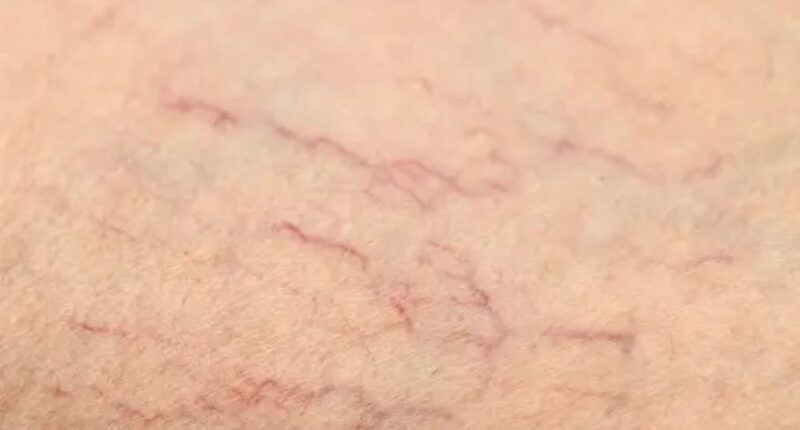Our body contains extremely thin-walled veins that provide blood, oxygen, and nutrients to our organs, tissues, and cells. These veins are called blood vessels.
Due to some diseases, these vessels are broken and enlarged in size. These vessels are also known as spider veins, petechiae, purpura, or telangiectasia.
In this article, we will look at the causes of broken blood vessels in face and its treatment.
Broken Blood Vessels:
Broken blood vessels are purple or red lines beneath our skin that enlarge due to different internal or external factors in our body.
Broken blood vessels can appear at any age and any part of the body, but are mostly found on the legs, face, eyes, nose, and cheeks.
These can be harmless in bruises from a bump but require attention in large areas or sensitive organs like eyes (subconjunctival hemorrhage), brains, etc.
Spider veins can be more prominent due to some medications or underlying health issues.
Cause of broken blood vessels in face:
As spider veins are extremely thin-walled, they constantly break and contract. It is a natural process but some factors contribute to developing broken blood vessels in face including:
- Genetics
- Inflammation
- Harsh weather conditions
- Smoking
- Low-quality skincare
- Harsh products
- Sunburn
- Stress
- Hormones
- Rosacea
- Spicy foods or caffeine
- Sun damage
Treatment options for broken blood vessels:

You need to consult your doctor if you are experiencing broken blood vessels in face.
They prescribe treatment based on the condition of your broken blood vessels. Here are some common treatments used to heal broken blood vessels in face:
- Microphlebectomy
- Intense pulsed light (IPL)
- Laser treatment
- Thermocoagulation
Microphlebectomy:
Microphlebectomy is a treatment in which broken blood vessels are removed using 1–3 millimeter tiny incisions.
This treatment generally does not require general anesthesia and can easily be performed with minimal downtime.
Intense pulsed light (IPL):
Intense pulsed light (IPL) treatment is also known as a photo-facial.
Intense pulsed light has a broader spectrum of wavelengths that help to remove broken blood vessels without surgery.
Laser treatment:
Laser therapy is a non-invasive treatment in which laser lights are used to heat and destroy broken blood vessels.
These laser lights target the colored veins, not the surrounding area.
In laser therapy you can face heat, irritation, or inflammation however modern laser devices are safe and trusted and have a low risk of complications.
Small veins can heal immediately but large veins can take 1-3 months to heal.
Thermocoagulation:
Thermocoagulation is treated by heat, but it is different from ipl and laser therapy.
In thermocoagulation, an ultra-thin needle is injected into the spider veins and heated to seal vessel walls.
After sealing the walls blood no longer passes through these vessels and spider veins disappear.
Home remedies for broken capillaries:

It’s important to understand that there are no scientifically approved home remedies for broken blood capillaries, but some skincare techniques can prevent broken capillaries:
Cold Compress:
Apply a cold compress wrapped in a thin cloth to the affected area for 10-15 minutes at a time.
Repeat a few times a day. The cold temperature helps constrict blood vessels, potentially reducing redness.
Sun Protection:
Sun exposure can worsen the appearance of broken capillaries. Always wear sunscreen (SPF 30 or higher) daily, even on cloudy days.
Healthy Diet:
Diet plays an important role in keeping your skin healthy. Proper intake of fruits, vegetables, and grains in your diet can prevent broken capillaries.
Vitamin C:
Vitamin C is an antioxidant that boosts collagen production and promotes healthy skin.
You can take vitamin C from different sources and diets including fruits, berries, leafy greens, and vitamin C supplements (before taking any vitamin C supplement consult your doctor first).
Witch Hazel:
Witch hazel is a natural astringent and reduces inflammation. It also helps to control oil production and remove grime and excess traces of makeup that remain even after washing your face.
Soak a cotton ball in witch hazel for broken capillaries and apply it to the affected area but be careful as it can dry out the skin, so use it sparingly and moisturize well afterwards.
Preventing broken blood vessels in face:
You can prevent spider veins on your face by using the following factors:
- Reduce alcohol consumption
- Avoid excessive sun exposure
- Use apple cider vinegar
- Use broad-spectrum sunscreen
- Moisturize regularly
- Manage stress
- Strengthening exercises
- Eat a balanced diet
- Manage blood pressure
- Avoid smoking
When to see a doctor:
Generally, broken blood vessels in face are harmless, but if you don’t like these veins, you can consult a board-certified dermatologist.
These professionals will examine your skin surface and then treat broken blood vessels with a suitable method.
Also, read Pimple Patches: Working, Benefits, Reviews, And More!










